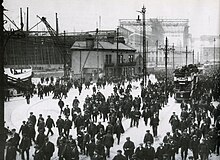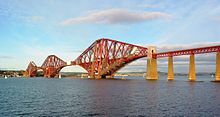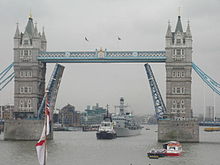Sir William Arrol & Company
Sir William Arrol & Co. was a bridge and crane construction company founded in Glasgow , Scotland in 1872, best known for building some of the most famous bridges in the world.
William Arrol and Co of Dalmarnock Ironworks, Preston Street, Bridgeton, Glasgow
The company's founder, Sir William Arrol, was born in Houston , Renfrewshire in 1839, the son of a weaver , and started working in a cotton mill at the age of nine. At the age of 13 he began an apprenticeship with a farrier and learned the basics of mechanics and hydraulics in evening school . In 1863 he joined a Glasgow bridge construction company, but in 1868 (1872) he founded his first company, Dalmarnock Iron Works , in the eastern part of the city. In the late 1870s he finally founded the construction company Sir William Arrol & Co. , which would become a leading company in its branch. Arrol was knighted in 1890 . On January 2, 1893, his company was converted into a stock corporation. In addition to bridges, the company also built the Great Wheel in 1894/1895 on the occasion of the Empire of India Exhibition.
Arrol was also active as a politician for the English Liberal Party. He was elected Member of Parliament (MP) of the constituency of South Ayrshire for his party in 1895 and held this position until 1906. He spent his retirement years on his estate in Seafield, near Ayr , where he died in 1913. At the beginning of the First World War , 1,500 people were employed, in 1961 there were 2,150. Sir William Arrol & Co. supplied container cranes to British Rail Freightliner in 1968 and was taken over by Clarke Chapman the following year .
Firth of Tay Bridge
After Arrol was commissioned to build the Caledonian Railway Bridge over the River Clyde in 1878 , he was given the task of rebuilding the Firth of Tay Bridge , which collapsed in 1879, in 1882 . The next big job for his company was the design and construction of the Firth of Forth Bridge, which was completed in 1890. Both bridges were the largest of their kind in the world at the time. The use of steel for the construction of the Firth-of-Forth Bridge and a method newly developed by Arrol to rivet the girders together was also remarkable .
Firth of Forth Bridge
With the Firth of Forth Bridge , Arrol's construction company created a bridge structure that is still very well known today. After a construction started in 1879 according to the plans of the engineer Thomas Bouch was stopped after the Firth-of-Tay-Bridge near Dundee , which was also built by him, collapsed on December 28, 1879, the engineers Sir John Fowler and Benjamin Baker were commissioned with the Planning a more stable bridge. The result was an exceptionally solid cantilever bridge . The 2.5 km long, two-lane bridge with a roadway height of 46 m above the flood water level was officially opened in 1890. It consists of three diamond - shaped truss girders, each 110 meters high , 495 and 2 × 460 m in length with four connected viaducts . The bridge was built by around 4,500 to 5,000 workers and consists of around 54,000 tons of steel.
Other bridges
Arrol was involved in the Tower Bridge in London, which was built from 1886 to 1894, along with the other main contractors Sir John Jackson (foundations), William George Armstrong (hydraulics), William Webster and Herbert Henry Bartlett . 432 construction workers under the leadership of civil engineer EW Crutwell built the structure from around 70,000 tons of concrete and over 11,000 tons of steel . Other Arrol bridges were the Nile Bridge in Egypt and the Hawkesbury Bridge in Australia .
Harland and Wolff
Sir William Arrol & Co. also received the order to erect a gantry crane system over the construction of the Harland & Wolff shipyard in Belfast in order to enable the construction of a series of three large Olympic-class passenger ships from 1908 , including the Titanic . Like the ships of the Olympic class, the gantry crane system was also one of the largest and most powerful crane systems of its kind in the world and, as the "Arrol Gantry", became a landmark both for the shipyard and for its designer.
Another of Arrol's works is the "Titan" shipyard crane still preserved today at the former John Brown & Company shipyard in Clydebank .
literature
- Peter R. Lewis: Beautiful Railway Bridge of the Silvery Tay: Reinvestigating the Tay Bridge Disaster of 1879 . Tempus, 2004, ISBN 0-7524-3160-9 .
- Charles McKean: Battle for the North: The Tay and Forth bridges and the 19th century railway wars . Granta, 2006, ISBN 1-86207-852-1 .
- John Rapley: Thomas Bouch: the builder of the Tay Bridge . Stroud: Tempus, 2006, ISBN 0-7524-3695-3 .
- PR Lewis: Disaster on the Dee: Robert Stephenson's Nemesis of 1847 . Tempus Publishing (2007) ISBN 978-0-7524-4266-2 .
Web links
- Company description on Gracesguide (English)
- The Gazeteer for Scotland on William Arrol
- Sir William Arrol & Company. In: Structurae
- Crane becomes visitor attraction . In: BBC News , July 27, 2007. Retrieved August 7, 2008.
- Early documents and newspaper articles on Sir William Arrol & Company in the 20th century press kit of the ZBW - Leibniz Information Center for Economics .



